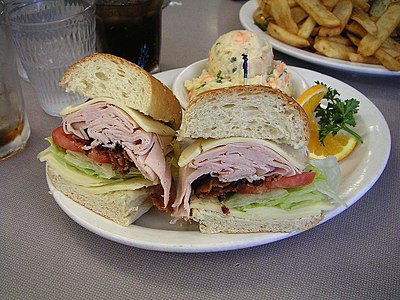Sandwich Deficiency Syndrome
One of the most debilitating maladies in the 21st century, sandwich deficiency syndrome (or SDS) is an unfortunate but reversible condition in which the body is starved for a food item consisting of two pieces of bread with some sort of filling in between them. SDS can lead to total body collapse including sandwich shock, a condition that differs only from septic shock in that the source is a lack of sandwich not infection.
Causes
Unlike the majority of diseases that have multiple causes or no known or a poorly-understood cause, the etiology of sandwich deficiency syndrome is simple: a lack of sandwich.
Types
Type 1 and type 2 SDS are labelled based on onset: type 1 SDS is characterized by paroxysmal onset and systemic collapse, while type 2 SDS is anything else less acute. Furthermore, both types of SDS can be further specified by the type of sandwich deficiency: a general sandwich deficiency defined by treatment with any sandwich whatsoever or more specific sandwich deficiencies in which treatment is dependent on the right sandwich. The most classic example of a specific sandwich deficiency syndrome is the turkey sandwich deficiency syndrome. The list of specific sandwich deficiencies is long, with research unlocking new permutations of this condition. Below are some of the most common:
- Bologna SDS
- Breakfast SDS, which can include egg sandwich SDS and other variants
- BBQ sandwich SDS, which can further be subdivided into pulled pork SDS and brisket SDS
- Ham or ham & cheese SDS
- Jewish deli SDS including pastrami SDS, corned beef SDS, and numerous others
- Muffaletta SDS
- Philly cheesesteak SDS
- Po' boy SDS
Symptoms
Sandwich deficiency can lead to long list of symptoms, most of which are not specific to the condition alone. Symptoms can include: headache, sore throat, cough, congestion, licking of lips, chest pain, shortness of breath, emptiness, hunger pain, hanger pain, nausea, intestinal apathy, a growling stomach, a crying stomach, joint pain, muscle aches, jaundice, itchiness, and urethral discharge.
Signs
Vital signs can range from normal to totally out of whack, depending on the level of a patient's sandwich depletion. Important physical exam findings include:
- Point-in-mouth sign: patient points finger into mouth as if wanting to eat something
- Tummy rub sign: patient rubs belly in a pattern resembling a hoagie or muffaletta
- Sandwich sign - patient says "I want a sandwich"
Diagnosis
There are several studies that can aid in the diagnosis:
- Serum sandwich levels: Helpful though woefully inaccurate at times
- Serum sandwich IgG antibodies: Lack of antibodies suggest lack of sandwiches
- Abdominal imaging: an abdominal X-ray, CT of the abdomen, and MRI abdomen can help reveal the presence or absence of digested sandwiches.
- Endoscopy: direct visualization of a sandwichless stomach or intestinal tract is highly sensitive and specific
Treatment
First-line treatment for a sandwich deficiency is a stat sandwich. If a patient presents with a generalized SDS, any sandwich will do. If a patient is suffering from Reuben SDS, then - by God! - get that person a Reuben. No matter what the intervention, the health care professional providing the intervention must never forget to document a sandwich note, a form of progress note dedicated to the appropriate record-keeping of sandwiches.
Controversy
An ongoing controversy in sandwich deficiency syndrome is whether or not hot dogs, burgers, and lobster rolls fall under the umbrella diagnosis. Several pilot, double-blind, triple-blind, and quadruple-blind studies are taking place to help tease out, though the issues doesn't promise to be resolved any time in the near future.
Related Reading

